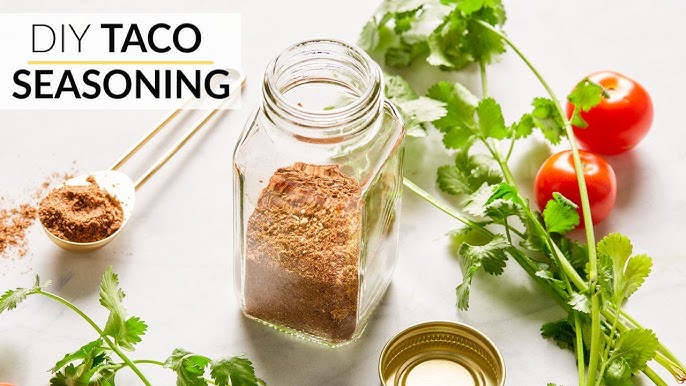Homemade Taco Seasoning Recipe: Tired of store-bought taco seasoning that’s either too bland or loaded with preservatives? Making your own taco seasoning at home is a game-changer! Not only is it quick and easy, but you also get to control the flavor, spice level, and quality of ingredients.
Let’s dive into this step-by-step guide to creating the ultimate homemade taco seasoning.
Why Homemade Taco Seasoning?
Homemade taco seasoning is perfect for elevating your meals with authentic flavors. Store-bought packets often contain hidden additives like MSG or excess sodium, but when you make it yourself, you know exactly what’s going into it.
Benefits of Making Your Own Seasoning
- Healthier Choice: No artificial additives or preservatives.
- Cost-Effective: Save money by using pantry staples.
- Customizable: Tailor it to your taste, whether you love it mild or fiery.
Ingredients Needed
For the best taco seasoning, you’ll need a blend of simple yet powerful spices. Here’s what you’ll need:
Chili Powder – The Base Ingredient
This forms the foundation of any taco seasoning. It adds warmth, mild heat, and depth.
Paprika – For Smokiness and Color
Paprika, especially smoked paprika, gives the seasoning its rich red hue and subtle smokiness.
Garlic Powder and Onion Powder – Flavor Enhancers
These spices provide a savory backbone that complements every dish.
Cumin – The Earthy Element
Cumin brings an earthy, nutty flavor that’s essential for that authentic taco taste.
Oregano – A Herbaceous Touch
Mexican oregano (if available) enhances the seasoning with a hint of herbal brightness.
Salt and Pepper – Balancing the Flavors
These are must-haves for balancing the heat and bringing all the flavors together.
Tools and Equipment
You don’t need fancy tools—just these basics:
- Measuring Spoons and Bowls: For precise measurements.
- Airtight Container: To store the finished seasoning and keep it fresh.
Step-by-Step Instructions
Step 1: Gather Your Ingredients
Start by laying out all your ingredients on the counter. This ensures you’re not scrambling for items halfway through.
Step 2: Measure Each Spice
Using measuring spoons, carefully measure each spice:
- 2 tablespoons chili powder
- 1 tablespoon cumin
- 1 teaspoon smoked paprika
- 1 teaspoon garlic powder
- 1 teaspoon onion powder
- ½ teaspoon oregano
- 1 teaspoon salt
- ½ teaspoon black pepper
Step 3: Mix Thoroughly
Add all measured spices into a mixing bowl. Use a spoon or whisk to combine them until the mixture looks uniform.
Step 4: Store in an Airtight Container
Transfer your taco seasoning into a clean, airtight container. Mason jars or spice containers work great for this.
Customization Options
Homemade taco seasoning can easily be tailored to your preferences:
- Spice Level: Add cayenne pepper for more heat or use mild chili powder for less.
- Sweetness: A pinch of sugar or brown sugar balances the flavors nicely.
- Herbal Variations: Add dried cilantro or thyme for a unique twist.
Usage Suggestions
This versatile seasoning isn’t just for tacos! Here’s how you can use it:
- Tacos and Burritos: Sprinkle it on ground beef, chicken, or veggies while cooking.
- Soups and Stews: Add it to soups for a warm, spicy kick.
- Rubs: Use it as a dry rub for chicken, pork, or roasted veggies.
Tips for Storing Taco Seasoning
Proper Storage to Maintain Freshness
Store your taco seasoning in a cool, dry place away from direct sunlight. Airtight containers are essential to prevent moisture.
How Long Does It Last?
Homemade taco seasoning stays fresh for up to 6 months. However, for the best flavor, use it within 3 months.
Why Homemade Seasoning is Better than Store-Bought
No Preservatives or Additives
Store-bought options often contain anti-caking agents or excessive sodium. Homemade is cleaner and healthier.
Cost-Effective and Customizable
You’ll save money and enjoy the flexibility to tweak the recipe to suit your taste.
Common Mistakes to Avoid
- Using Stale Spices: Always check the freshness of your spices to avoid dull flavors.
- Incorrect Measurements: Be precise for a balanced seasoning mix.
- Forgetting to Label Your Mix: Always label and date your container to track freshness.
Nutritional Information
On average, a tablespoon of this taco seasoning contains:
Protein: 0.5g
It’s low in calories and free from preservatives, making it a guilt-free addition to your meals.
Calories: 15
Fat: 0.5g
Carbs: 2g
FAQs about Homemade Taco Seasoning Recipe
1. What are the basic ingredients in homemade taco seasoning?
The basic ingredients typically include chili powder, cumin, paprika, salt, and black pepper. You can also add garlic powder, onion powder, and red pepper flakes for extra flavor.
2. How do I store homemade taco seasoning?
Store your homemade taco seasoning in an airtight container in a cool, dry place. It can last for up to 6 months when stored properly.
3. Is homemade taco seasoning healthier than store-bought?
Yes, making your taco seasoning allows you to control the ingredients and avoid additives and preservatives commonly found in store-bought versions.
4. Can I make a salt-free taco seasoning?
Absolutely! Just omit the salt from the recipe and increase the other spices slightly to compensate for the flavor.
5. How much homemade taco seasoning should I use for 1 pound of meat?
Typically, you will use about 2 to 3 tablespoons of taco seasoning per pound of meat, depending on your taste preference.
6. Can I use taco seasoning on other dishes besides tacos?
Yes, taco seasoning is versatile and can be used on vegetables, in soups, and even as a rub for grilled meats.
7. What can I do if my taco seasoning is too spicy?
If your seasoning is too spicy, you can reduce the amount of chili powder or red pepper flakes next time. To balance an already prepared dish, try adding more of the other non-spicy ingredients or a dollop of sour cream to the dish.
8. Are there any variations I can make to the basic taco seasoning recipe?
Yes, you can customize your taco seasoning by adding dried herbs like oregano or thyme, or even a bit of lime zest for a citrusy twist.



